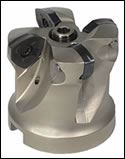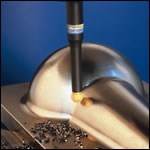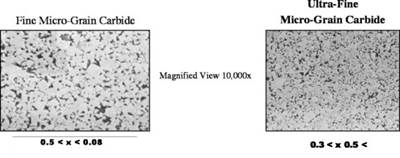Match Cutting Tools To Machine for Maximum Efficiency
A large range of tooling enables moldmakers to match cutting tool to machine and part geometry, resulting in maximum metal removal rates and productivity for roughing applications on conventional and high-speed machining centers.
For many machining applications, it is needless to worry whether or not your machine has enough power to perform what you are asking of it; how-ever, there are instances (usually roughing applications) that require the programmer/operator to figure how much power is required to operate a given cutter. The need to calculate power consumption can become even more important when using machines equipped with high-speed spindles that usually generate very little horsepower at lower rpms. For these machines, it is often necessary to apply smaller diameter cutters in order to run at optimum parameters for machine, cutting tool and material to be machined. The following information will discuss a few areas that need to be addressed as well as new cutting tool technology being applied in the moldmaking industry today for maximum efficiency in roughing applications.
Know Your Machine
To determine if a machine has the power to operate at a given set of parameters, personnel must familiarize themselves with the spindle power chart of the machine. The spindle power chart will reveal the horsepower and torque characteristics of the machine and is usually split into two separate ratings (30-minute and continuous ratings). This chart should be kept handy for reference.
Estimating Power Consumption
As mentioned earlier, determining the horsepower necessary to operate a given tool can be very important. Much has been written on how to estimate the amount of power needed to machine a given material. The following information will cover the basics.
The common method for determining horsepower consumption for a given tool is to multiply the metal removal rate (mrr) by the power factor. The metal removal rate (mrr) is obtained by multiplying width-of-cut, depth-of-cut and feedrate of the tool being used (mrr = woc * doc * F). The power factor (p factor) is a predetermined power constant and varies for different materials, it is determined by the amount of horsepower required to cut a given material at a rate of one cubic inch per minute (charts showing power constants for materials with various hardness levels can be found in publications such as the machinist handbook).
It is important to note that this method of figuring horsepower is merely an estimate and there are many other factors that con-tribute to horsepower calculations. The efficiency of the machine tool spindle, mat-erial hardness, cutter and insert geometries, cutting fluids, tool wear, and more can all have an effect on horsepower requirements.
It is clear that many factors need to be considered when making horsepower calculations and that the cutting tool is one of those factors. In some instances, when using high feed cutting tools for roughing applications, the machine spindle will be the deciding factor when determining cutting tool diameters and machining parameters to be used. For roughing operations on any machine, and in particular those machines with smaller spindle connections such as CAT/BT 40 and HSK40, it is important to make the required power calculations, knowing where to begin in order to achieve maximum productivity while avoiding undesirable spindle overloads and cutting conditions. A machining power calculator—which covers these new high feed cutting tools and greatly reduces the time and effort needed to estimate power consumption for milling, drilling and turning applications—has been developed. By choosing from drop down menus and filling in some remaining information about cutter, cutter geometry, speed, feed, etc., programmers/operators can quickly determine whether or not the machine has approximately enough horsepower for the application at hand.
Cutting Tool Technology for Roughing Applications
Now that you know how to get the most out of your machines for roughing applications, it is time to discuss getting the most out of your cutting tools. A new design of cutting tool has been developed specifically for maximizing metal removal in roughing operations, which allows the use of very high feedrates, producing metal removal rates that can significantly reduce the cycle time and cost involved with roughing operations.
The tools work very well on both 2-D and 3-D part geometries and come in a variety of styles and sizes. Another option for users is to go with modular style tooling that allows the flexibility of using different shanks with screw on heads, enabling the operator to set the projection length and attain maximum rigidity for each application.
For smaller applications, cutting tools with replaceable inserts designed for high feed applications have been developed. Available in 10, 12 and 16mm, these tools are capable of operating at very high feedrates (12 mm tool running at 300 i.p.m. in tool steel at .025 depth cut) and are effective for improving metal removal on machines equipped with high-speed spindles and lower horsepower. The replaceable insert also is a more economical solution when compared to that of solid carbide and is successful in milling hardened tool steel up to approximately 54 Rc.
Having a large range of tooling enables personnel to effectively match cutting tool to machine and part geometry, achieving maximum metal removal rates and productivity for roughing applications on both conventional and high-speed machining centers. In many cases while using high feed roughing tools, near net shape roughing can be achieved by the use of smaller diameter high feed tools without giving up much—if any—in terms of metal removal and productivity. In fact, when compared to other commonly used roughing tools, it is possible for smaller diameter high feed roughing tools to surpass the metal removal rates of larger diameter cutters using more conventional machining parameters and methods. Another benefit to using smaller diameter high feed tooling is that the smaller tools are capable of getting closer to the net shape of the part and this reduces the amount of re-machining and programming required to remove leftover stock before finishing operations can begin.
Summary
How do you know if you're making the most from each application? An understanding of machine capabilities as well as new cutting tool technology and how it can be applied is important for programmers/operators to optimize applications as well as avoid costly mistakes. Through the use of high feed cutting tools and by properly matching those tools to machine, part geometry and material, companies can realize significant time cost savings for roughing applications. In conclusion, the more metal to remove, the more the excess metal re-moval rates achieved by high feed cutting tools will keep compounding the savings.
Related Content
What You Should Consider When Purchasing Modified P20 Steel
When buying P20 steels that have been modified, moldmakers must be aware of the variations and key issues that affect delivery, cost and lead times.
Read MoreHands-on Workshop Teaches Mold Maintenance Process
Intensive workshop teaches the process of mold maintenance to help put an end to the firefighting culture of many toolrooms.
Read MoreRevisiting Some Hot Runner Fundamentals
What exactly does a hot runner do? If you’ve been in the injection molding industry for any length of time, you might think the answer is obvious, but it is not.
Read MorePlastic Prototypes Using Silicone Rubber Molds
How-to, step-by-step instructions that take you from making the master pattern to making the mold and casting the plastic parts.
Read MoreRead Next
Advanced Cutting Tools Translate To Greater Cost Savings
Increasing initial tooling investments will allow moldmakers take home more profits at the end of the day.
Read MoreHow to Use Continuing Education to Remain Competitive in Moldmaking
Continued training helps moldmakers make tooling decisions and properly use the latest cutting tool to efficiently machine high-quality molds.
Read MoreAre You a Moldmaker Considering 3D Printing? Consider the 3D Printing Workshop at NPE2024
Presentations will cover 3D printing for mold tooling, material innovation, product development, bridge production and full-scale, high-volume additive manufacturing.
Read More















.png;maxWidth=300;quality=90)















